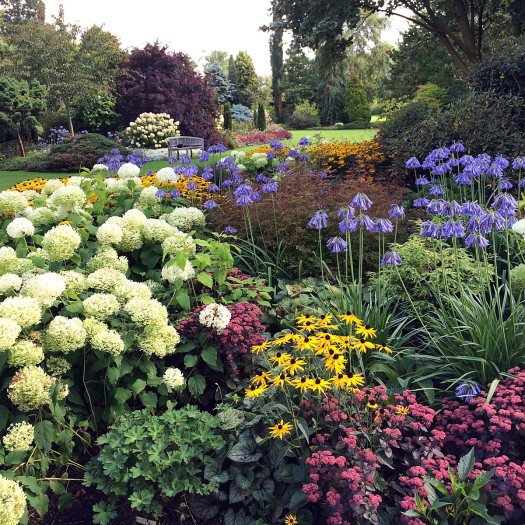
A border is a cultivated area of land set aside for growing decorative plants. Mixed borders combine different types of plants in one place: trees, shrubs, perennials, annuals, grasses, bulbs and climbers on obelisks or against a wall. Anything you like to grow can be included – if you want to accessorise it with a birdhouse or seat or some form of artwork, so much the better!
Because there isn’t a fixed recipe, mixed borders are versatile and popular. You may well be one of millions of gardeners worldwide who are tending one.
In a mixed border, trees, shrubs and evergreens provide year-round structure. Herbaceous perennials die back to ground level in winter, reappear in spring and are at their finest in summer and autumn. Annuals or biennials fill any gaps, add colour and ring the changes from year to year. Bulbs and ephemerals fill in some of the gaps before the perennials reappear.
While the biggest advantages of mixed borders are their potential to give year round colour and interest, there are a few things to consider when planning one. They are not always as low maintenance as they may look. A mixed border will most likely need some attention all year round. As plants grow at different rates, some will become congested and need to be dug up, divided and replanted to keep them growing well and to maintain balance.
Bressingham Gardens offers a masterclass in this type of planting. The trees chosen have contrasting forms (branching, columnar, mounding) and green, copper or silver-blue foliage. Shrubs include hydrangeas (including lots of Hydrangea ‘Annabelle’, pictured above), azaleas and rhododendrons. Herbaceous perennials are planted with rhythm, choices being limited to reliable varieties, including many released or popularised under the Blooms of Bressingham brand. Agapanthus, geranium, brunnera, sedum, rudbeckia are shown here.
For those in visiting mode and within reach, Bressingham Gardens cautiously reopened last month. A ticket booking system is in place for everyone, even season ticket holders, but availability seems to be good. Please check the website to find out what’s open and the latest position as I’m sure things will change over the next few months.
Shared for July Squares as the tiny garden seat helps give a sense of perspective.

Oh to be produce a border like that, one can only dream – it’s just beautiful and what a great picture!
It’s beautifully maintained too.
Beautiful! I expect that limiting numbers entering gardens might enhance enjoyment, without the crowds that sometimes try one’s patience. I’d love that to be permanent, but I understand that economics might not allow that.
It is a great treat to be able to go round a garden when it is quiet, but I rarely see gardens in England as busy as I think they ought to be.
The yellow flowers in your picture look like black-eyed susans (Rudbeckia hirta), or something akin to that.
If I was to guess it would be Rudbeckia fulgida var. sullivantii ‘Goldsturm’. That’s always popular.
I see what you mean: the article at
http://www.missouribotanicalgarden.org/PlantFinder/PlantFinderDetails.aspx?kempercode=i780
says this: “Var. sullivantii, commonly called Sullivant’s coneflower, is native to swamps, shorelines, fens and sedge meadows from New York to West Virginia west to Michigan, Illinois, Missouri and Arkansas. Var. sullivantii is not commonly sold because of the extreme popularity of its ornamentally upscale cultivar ‘Goldsturm’.”
That sounds like an interesting class to take. A beautiful thriving mixed border like that doesn’t happen by chance.
It’s owned by a family with a great heritage as nurserymen and women. I dare say they’ve learned a lot by trial and error over the years.
The border is beautiful. I always love the English borders ; full to the brim with color and interest.
I’m glad you like it. The aim is to leave no soil bare, or at least not in summer.
Bressingham a truly inspirational garden.
I really enjoyed it and wish it was closer.
“… not always as low maintenance as they look.” Yes, but isn’t that true of every kind of border? My own tastes have evolved from strictly perennial borders to a more mixed approach. Self-seeding annuals like Borage can add so much fullness and color to a border, and then there are colorful long-blooming summer annuals like Tithonia – I couldn’t do without them!
Very true. Borage is a great plant. One of my favourite little patches of garden along my regular walks has had annuals and biennials that seemed to have self seeded in among bluebells of different colours. It has changed a little every few days but always looked delightful.